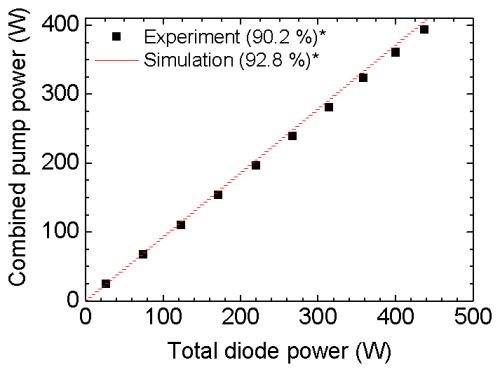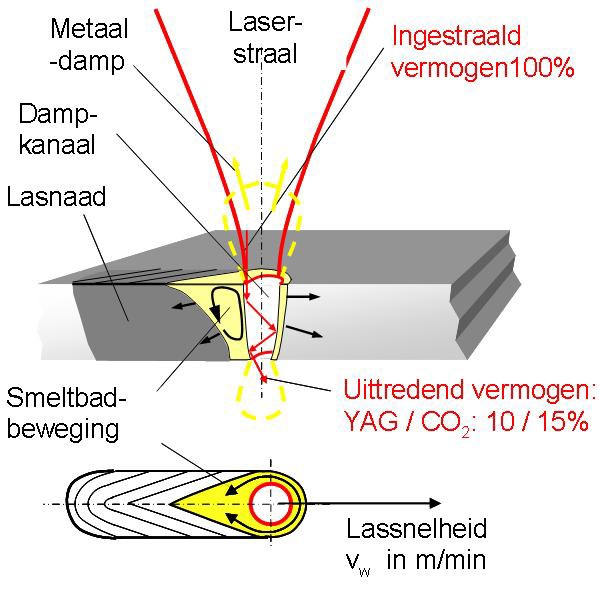Pump and signal combiner for bi-directional pumping of all-fiber lasers and amplifiers(8)
5.2 Simulations of the loss mechanism caused by additional pump ports
As already discussed, the total power loss is comprised of TP, PAA and PCT. Since a TL of 20 mm and a TR of 6 seem to be promising parameters for a fiber combiner with multiple pump ports, Fig. 9
Fig. 9 Simulated losses for a
pump combiner with a TL of 20 mm and a TR of 6 providing up to 6 pump ports. Please see Fig. 1for TP, PCT and PAA.
illustrates the behavior of the 3 different loss mechanisms and the total power loss against the number of pump ports. The input pump light NA of the PFFs was 0.22. The simulations clearly show that the TP-fraction as well as the PAA-fraction increase with the total power loss, and the PCT-fraction stays almost constant. The NA-mismatched pump light, which couples into the coating of the target fiber (PCT) can be kept below 1.7%, even up to 6 pump ports. Hence, an increasing number of pump ports and, therefore, scaling of the combined pump power results in additional power losses, but with an insignificant increase of thermal load to the coating of the TF. Of course, due to an increased PAA the combiner housing would be exposed to a higher thermal load, but this can be handled by an adequate thermalconcept. The increased PAA can be explained by pump light rays which couple back from the TF into one of the IFs, further propagate in the converging taper portion of the IF, increase in NA and undergo refraction into the ambient air. The increase of the TP-fraction with additional pump ports can be caused by pump light rays with a low NA which reverse couple into one of the IFs and further propagate there.
Finally, the simulations show that the total pump power loss increases with each additional pump port but the PCT, resulting in thermal load of the TF, does not increase significantly compared to a fiber combiner with a single pump port. In general, for the optical design of a side-pumped coupler with multiple pump ports, a TL as short as possible in conjunction with a TR as low as possible, but still satisfying the required pump coupling efficiency for the desired number of pump ports, ensures efficient pump light combining with low power losses. In contrast, for a single pump port, a longer TL in conjunction with a low TR is advantageous for increasing the pump coupling efficiency and reducing PCT-losses in particular.
5.3 Experimental characterization of pump combiners with multiple pump ports
Since the simulation results indicate that a TL of 20 mm and a TR of 6 are useful taper parameters, fiber combiners with two, four and six pump ports were developed. Each pump port consisted of an IF with a measured TL of 18 mm and a measured TR of 6.7. Each PFF had a NA of 0.15, and to characterize the combiner was connected to a pump diode (Oclaro BMU25) with a pigtail fiber delivering a maximum output power of about 25 W at a wavelength of 976 nm. The delivery fiber of the pump diode had parameters identical to the PFF.
Figure 10(a)
Fig. 10 (a) Combined and transmitted power measured for a
fiber combiner with 4 pump ports and (b) combined pump power measured for a fiber combiner with 6 pump ports, * ratio of coupled or transmitted power to total diode power in percent.
shows the total diode power with respect to the
combined pump power and TP for a fiber combiner with four pump ports. For the combined pump power a coupling efficiency of 92% (93.1% in the simulation) was measured, and the fraction of TP was 3.6% (3.9% in the simulation) compared to the total diode power. Thus, the measured TP of 3.6% was 45% of the total power loss of 8% (Fig. 10(a)). Based on the good agreement between simulation and experiments it can be assumed that the PCT-fraction and PAA-fraction were about 0.6% and 2.3% of the total diode power, respectively.
Microscope images of the top view and of the cross section view, close to the taper waist, of a fiber combiner with 4 pump ports are depicted in Fig. 11(a)
Fig. 11 Microscope image of (a) the top view and (b) the cross section view of a fiber combiner with 4 pump ports.
and 11(b).
The experimental results of a developed six pump port fiber combiner with a combined pump power of 141.5 W and an obtained coupling efficiency of 89.6% (91.1% in the simulations) is shown in Fig. 10(b). The fiber combiner with six pump ports was limited by the available pump power and not by thermal problems. For the combiner presented in Fig. 10(b), Fig. 12(a)
Fig. 12 (a) Pump coupling efficiency of the individual pump ports of the six pump port fiber combiner presented in Fig. 10(b) and10(b) comparison of the experimentally achieved pump coupling efficiencies with the simulation results for fiber combiners with multiple pump ports.
shows the pump coupling efficiency of each individual pump port with a maximum and minimum pump coupling efficiency of 90.2 and 88.8%. The difference of only 1.4% indicates a very homogeneous fiber bundle structure, and supports the assumption of identical optical behavior of the individual pump ports.
An overview of the experimentally obtained coupling efficiencies with the corresponding simulation results for a fiber combiner with 1, 2, 4 and 6 pump ports is depicted in Fig. 12(b). An agreement of the experimental and simulated results within 1% confirms the applicability of the simulation approach for multiple pump ports. For each fiber combiner a TL of 18 mm, a TR of 6.7 and a PFF with a core NA of 0.15 was applied.
About DK Photonics
DK Photonics –
www.dkphotonics.com specializes in designing and manufacturing of high qualityoptical passive components mainly for fiber laser applications such as
1064nm high power isolator,Cladding Power Stripper,Multimode High Power Isolator,
pump combiner,1064nm Band-pass Filter,(6+1)X1 Pump and Signal Combiner,PM Circulator,PM Isolator,optical Coupler.More information,please contact us.





